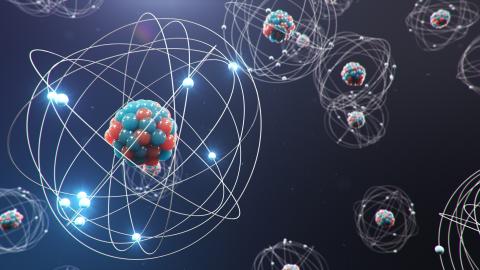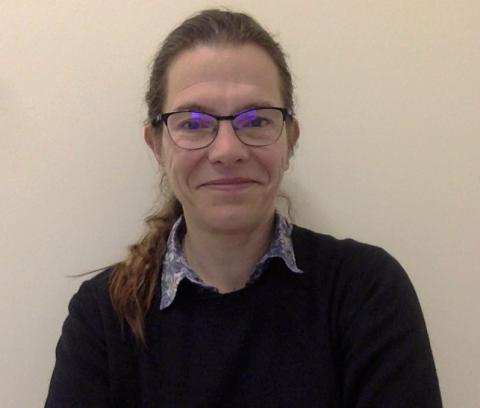
Araceli Lopez-Martens: from superdeformed nuclei to superheavy nuclei
Araceli Lopez-Martens is a research director at the National Centre for Scientific Research (CNRS) and a researcher in experimental nuclear physics at the Laboratory of the Physics of the two infinities Irène Joliot-Curie (IJCLab - Université Paris-Saclay, CNRS, Université Paris Cité). She specialises in the study of the internal cohesion of atomic nuclei, and is interested in the phenomena of the extreme deformation of nuclei and superheavy nuclei. She has contributed throughout her career to the development of detection instruments. Her work led to her winning the CNRS silver medal in 2023.
After her baccalaureate, like many of her classmates, Araceli Lopez-Martens did not yet know what path to take in her studies. "It was on the advice of my father, a chemist by training, that I decided to go into physics, which he said led to everything," she recalls. This was the beginning of a journey to all four corners of Europe. After a double Bachelor's degree in Physics and Russian at the University of Sussex (UK), she did a first year of doctoral studies by preparing a Diploma of Advanced Studies (a former postgraduate diploma now equivalent to a master’s degree) in Fields, Particles and Materials at Université Paris-Sud (now Université Paris-Saclay). She then completed her PhD in Nuclear Physics at the Nuclear and Mass Spectrometry Centre (CSNSM, one of the five laboratories now merged to create IJCLab) on the study of nuclear phenomena at high angular momentum, and more particularly on nuclear superdeformation. This research led her to carry out experiments on the EUROGAM gamma ray multidetectors in Strasbourg and GAMMASPHERE in Berkeley.
She then carried out her post-doctoral work at the Niels Bohr Institute in Copenhagen (Denmark), studying the properties of electromagnetic radiation emitted by superdeformed nuclei. "I had the chance to join a lively group of theoretical physicists and experimentalists, where I could really feel the interest in confronting experimental data with theoretical predictions. This had a profound effect on the way I worked afterwards," she explains. In 1997, she joined the CNRS as a research fellow at the Institute for Subatomic Research (IReS), which became the Hubert Curien Pluridisciplinary Institute (IPHC) in 2006.
The study of superdeformed nuclei: from EUROBALL to AGATA
After her thesis, Araceli Lopez-Martens became interested in the study of the extreme forms of the nucleus with, as she specifies, "a particular emphasis on the de-excitation of superdeformed nuclei." When she joined IReS in 1997, she was in charge of commissioning the European gamma photon multidetector EUROBALL, which succeeded EUROGAM. "This instrument, the most powerful of its generation, made it possible to study nuclei in very powerful rotation in order to better understand the forces at play in the cohesion of their nucleons," she explains.
After the dismantling of EUROBALL in 2003, she became involved in the project to build a state-of-the-art multi-photon detector, the Advanced Gamma-ray Tracking Array (AGATA). AGATA is an international collaboration of 40 institutes in 12 different European countries. Its mission is to study the transition of exotic atomic nuclei from an excited state to a more stable state. "These very brief swings are accompanied by the emission of gamma rays that interact with the germanium crystals in the detector. The analysis of the traces of their passage helps us deepen our understanding of the nucleus," she explains. In the context of preparing the AGATA demonstrator, from 2003 to 2009, Araceli Lopez-Martens worked on the development of a gamma tracking algorithm, whose purpose is to facilitate the reconstruction of the trajectory of the radiation once it has interacted with the AGATA detector. She then took part in numerous experiments with AGATA and became its coordinator in France from 2016 to 2022.
The study of superheavy nuclei
At the same time as her research on superdeformed nuclei, in which her expertise is widely acknowledged, in 2004 she started to focus on superheavy nuclei. "To move forward on this topic, I had to find out more about experimental techniques and analysis methods," she explains. This led her to launch, together with IReS, an experimental research programme at the JINR-Dubna Cyclotron U400 in Russia, known as Gamma Alpha Beta Recoil Investigations with the ELectromagnetic Analyser (GABRIELA). "Thanks to two projects financed by the French National Research Agency (ANR), which I led in 2006 and 2012, we built a new separator and a high-performance detection system, with which we have validated innovative analysis techniques and obtained excellent results," says Araceli Lopez-Martens.
Among the most significant results was the discovery in 2020 of a new nobelium isotope, 249No, which earned her international acknowledgement and the CNRS Silver Medal in 2023, among other contributions. "On the topic of superheavy nuclei, I was also lucky enough to spend two years at the University of Jyväskylä in Finland. There, I took part in the commissioning and first experiments of the SAGE device, which is used for the simultaneous detection of photons and internal conversion electrons emitted by superheavy nuclei at the time of their formation in nuclear reactions," she adds.
Since 2009, Araceli Lopez-Martens has also been involved in developments related to the SIRIUS (Spectroscopy and Identification of Rare Isotopes using S3) detection system, which will soon be installed at the focal plane of the S3 spectrometer (Super Separator Spectrometer) at the Large Mational Heavy-Ion Accelerator (GANIL) in Caen.
Demystifying Nuclear Physics
In addition to her research activities, Araceli Lopez-Martens has always been committed to the dissemination of knowledge, whether through courses, public lectures or publications. Since her recruitment at the CNRS, she has supervised several interns and PhD students, organised a MOOC on superheavy nuclei for the Particles, Hadrons, Energy and Nuclei: Instrumentation, Image, Cosmos and Simulation (PHENIICS) doctoral school, given several courses to students (Bachelor's, Master's degrees and PhD) as well as lectures in high schools, all within the framework of the NEPAL programme. "Following my talk at the General Congress of the French Physics Society in 2011 to celebrate the centenary of the discovery of the nucleus by E. Rutherford, I have given many talks and lectures for the general public on the same subject, and in 2019, for the 150th anniversary of the periodic table of elements," she says.
Araceli Lopez-Martens is particularly fond of these public talks. "I just love the history of scientific and technical advances. There are so many fascinating anecdotes which, because they demystify the process of acquiring knowledge, contribute to making our discipline more accessible to everyone. Going deeper into this story has clearly made me a better physicist. This is why I think it's really important to give a human face to research, to make as many people as possible want to get involved," she explains. It is therefore not surprising that, in 2019, CNRS Éditions sought her out to contribute, along with other researchers, engineers and scientists, to a popular science book entitled “Étonnants infinis” (Amazing infinities). She wrote the chapter entitled "Ce numéro n’est pas encore attribué" (This number is not yet assigned).

